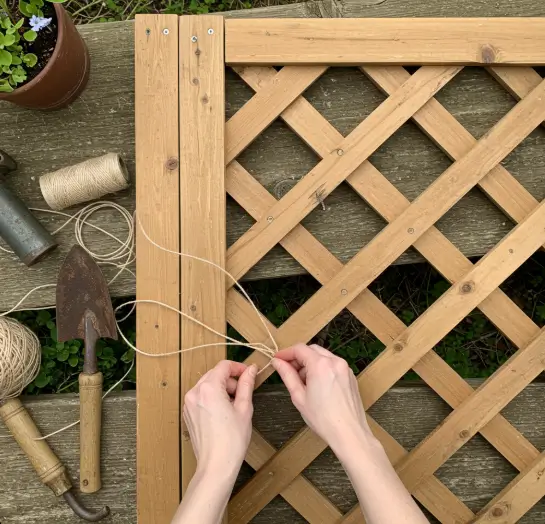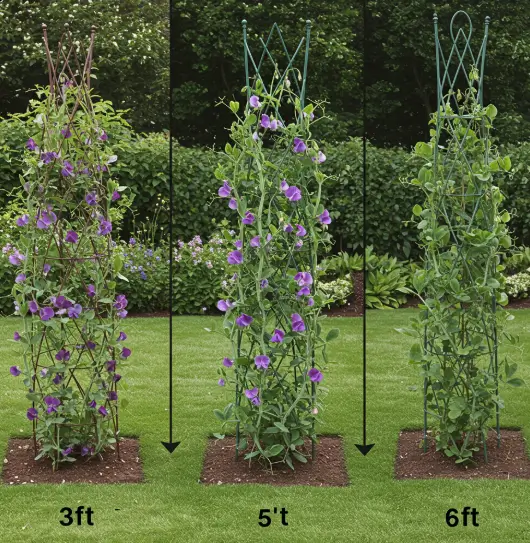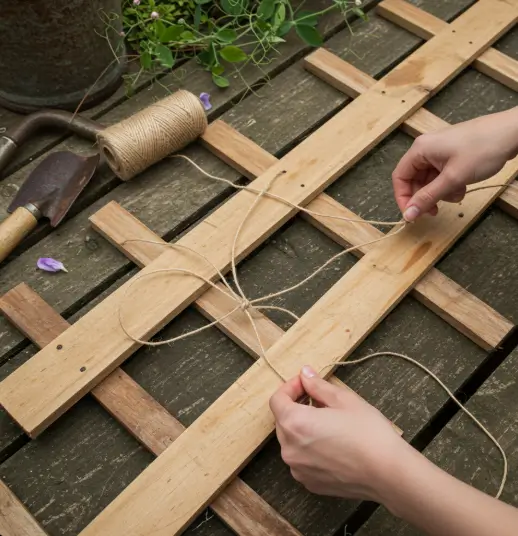Why Sweet Peas Need a Trellis
The Growth Habits of Sweet Peas
It all started one spring morning with my neighbor, Señora Ramirez, who had lived on our street since before I was born. I remember her handing me a bundle of Lathyrus odoratus—sweet peas—from her flourishing backyard. Their fragrance was unforgettable, their delicate blooms enchanting. As we sipped chamomile tea in her garden, she smiled and said, “They need something to climb, mija, or they’ll just tangle themselves in knots.”
Sweet peas are climbing vines by nature. They grow rapidly during cooler months and send out tendrils that cling onto nearby supports. These flowering vines can reach over six feet tall under the right conditions, but without a vertical plant training system, they sprawl along the ground, becoming susceptible to pests and mildew.
Table of Contents
Benefits of Using a Trellis for Sweet Peas
A DIY sweet pea trellis is not only functional but also decorative. It:
- Keeps plants upright and encourages better air circulation
- Prevents rot and fungal diseases by lifting foliage off the ground
- Enhances garden aesthetics with vertical color and structure
- Makes harvesting blooms easier and cleaner
Using a trellis for climbing plants also mimics the natural climbing behavior of sweet peas, supporting healthy growth and full blooms throughout the season.

Choosing the Right Type of DIY Sweet Pea Trellis
Popular Trellis Types: Arch, Teepee, Wall-Mounted, and A-Frame
When my aunt Lupe taught me how to grow sweet peas, she used whatever she had—old broomsticks, tomato cages, even curtain rods. But with experience, I found that the structure truly matters. Common garden trellis designs include:
- Arch Trellis: Adds an ornamental flair; best for large gardens
- Teepee or Obelisk: Ideal for containers and small plots
- Wall-Mounted Trellis: Saves space, great for vertical gardening
- A-Frame Trellis: Very sturdy and allows plants to grow on both sides
Each design has its place depending on the space and aesthetic of your garden.
Pros and Cons of Different Trellis Designs for Sweet Peas
| Trellis Type | Pros | Cons |
|---|---|---|
| Arch | Requires a strong installation | Sturdy, dual-sided growing |
| Teepee/Obelisk | Easy to build; ideal for containers | Limited growing surface |
| Wall-Mounted | Saves space; permanent | Needs wall support |
| A-Frame | Takes up more ground space | Takes more ground space |
Choosing the right trellis will depend on your environment and garden goals. I prefer the A-frame because of its versatility. It serves as a natural garden support and stands out as a rustic centerpiece in my flower bed.
Materials and Tools You’ll Need for a Sweet Pea Trellis
Best Materials for Constructing a Trellis: Wood, Bamboo, Metal, and String
I like to keep my projects sustainable, so I often use bamboo garden structure poles left over from tomato seasons. Here are the best materials for building a sturdy yet affordable trellis:
- Wood: Durable and easy to work with
- Bamboo: Lightweight and biodegradable
- Metal: Long-lasting but may rust without treatment
- String or Twine: Great for weaving across frames for vines
Bamboo remains my favorite due to its availability and visual appeal in a rustic trellis idea.
Check this article ( click here) to learn more about Bamboo Trellis.
Essential Tools for DIY Trellis Construction
To construct a reliable trellis, gather the following:
- Hammer or cordless drill
- Saw or garden clippers
- Measuring tape
- Zip ties, nails, or twine
- Garden gloves
- Safety goggles
Having these tools on hand makes assembly easier and ensures that your homemade plant trellis remains safe and stable for your sweet peas to thrive.
Step-by-Step Guide to Build a DIY Sweet Pea Trellis
How to Build a Sweet Pea Trellis with Bamboo or Wood
The first time I built a sweet pea trellis from scratch was with my mom in the backyard. We used repurposed bamboo poles from an old privacy screen and fashioned a simple A-frame.
Materials Needed:
- 6–8 bamboo poles or 1×2-inch wooden slats (6 feet long)
- Twine or garden wire
- Scissors and a measuring tape
Instructions:
- Lay out your poles in pairs to form an inverted “V” shape.
- Secure the tops using garden twine or screws.
- Spread the base ends approximately 18 inches apart.
- Connect the A-frames by laying horizontal poles across the tops, middle, and bottom.
- Weave string horizontally across the structure for the tendrils to grasp.
This method creates a vertical garden support ideal for any backyard.

Detailed Instructions for Creating a Freestanding or Wall-Mounted Trellis
Freestanding:
- Place each leg 6 inches deep into the soil
- Backfill and tamp firmly for stability
- Add cross braces if windy conditions are common
Wall-Mounted:
- Attach wood or metal grid directly to the wall using wall anchors
- Leave a 1-inch gap between the wall and the trellis for ventilation
- Use a netting or wire mesh trellis over the structure for easy climbing
Both methods offer strong support for sweet pea vines, allowing them to climb gracefully and bloom with abundance.
How Tall Should a Trellis Be for Sweet Peas?
Ideal Height for Maximum Growth and Airflow
Sweet peas can grow surprisingly tall—between 4 and 6 feet, depending on the variety. I find that building a plant training structure of at least 6 feet gives my sweet peas room to flourish without becoming cramped.
- Standard trellis height: 5 to 6 feet
- For dwarf varieties, 3 to 4 feet may suffice
- Container setups: Teepees around 4 feet
How Trellis Height Affects Flowering and Support
Height affects not only how the plant looks but also how it breathes. A taller trellis:
- Enhances air circulation, reducing mildew risk
- Improves sunlight exposure
- Encourages longer, stronger stems and more blooms
An insufficient trellis height may lead to entanglement and reduced flowering. The right size allows sweet peas to show their full climbing potential and offer an enchanting vertical display in your garden.

How to Make a Climbing Frame for Sweet Peas
Alternative Climbing Frame Designs to Traditional Trellises
If you prefer a more modular approach, climbing frames offer flexibility and mobility. I once used an old baby crib mattress frame to train sweet peas—it was unconventional but surprisingly effective.
Alternatives include:
- Rebar grids
- Lattice panels
- Upcycled wooden frames
- Hula hoop and string combinations
These serve as creative, budget-friendly sweet pea climbing frame alternatives.
When to Use a Frame Instead of a Trellis
Use a climbing frame if:
- You have container gardens or raised beds
- Your soil does not support stakes or posts well
- You want a mobile solution to rotate crops
Frames offer an advantage in tight spaces or rental gardens where permanent structures are impractical. Plus, they align well with garden DIY projects that emphasize reuse and creativity.

Tips for Installing and Maintaining Your DIY Sweet Pea Trellis
Best Placement in the Garden for Sun and Ventilation
I always install my trellis along the eastern fence where the sweet peas get morning sun and afternoon shade. This promotes longer blooming during the hotter months.
- Sun exposure: At least 6 hours of morning sunlight
- Wind protection: Shield from heavy gusts
- Spacing: Leave 6 inches between plants and trellis
Proper placement ensures your decorative garden trellis enhances both functionality and visual harmony.
How to Anchor, Clean, and Maintain Your Trellis Through the Seasons
Maintenance tips include:
- Inspect joints and bindings regularly
- Tighten twine or ties as needed
- Wash off dirt and debris with a hose each season
- Repaint or reseal wood to prevent decay
Good care prolongs the life of your wooden plant supports, keeping them strong for many future planting seasons.
Best Support Options for Sweet Peas: Trellis vs Other Methods
Comparing Trellis with Netting, Cages, and Stakes
There are multiple support methods for sweet peas:
- Netting: Lightweight but prone to sagging
- Tomato cages: Useful in containers, but restrictive
- Single stakes: Minimal but hard to train
Each option has limitations in terms of support and longevity.
Why a Trellis is Often the Best Support for Sweet Peas
In my experience, nothing beats a well-built trellis. It:
- Accommodates the natural climbing habit
- Allows easy access for pruning and harvesting
- Looks beautiful when fully in bloom
While netting and cages have their place, a trellis offers a pea plant support structure that combines form and function beautifully.
Frequently Asked Questions (FAQs) :
How to Make a Trellis for Sweet Peas?
A basic trellis can be made from bamboo poles tied into a teepee or from wooden slats assembled into an A-frame. Add twine or garden netting for climbing plants to provide additional grip points for tendrils.
How Tall Should a Trellis Be for Sweet Peas?
Aim for 5 to 6 feet tall for standard sweet pea varieties. For dwarf types, 3 to 4 feet is sufficient.
How to Make a Climbing Frame for Sweet Peas?
Use metal grids, upcycled furniture, or even stretched string over hoops. Climbing frames are especially helpful in container gardens.
What is the Best Support for Sweet Peas?
A trellis for climbing plants is generally the best choice. It supports natural growth patterns, prevents disease, and adds vertical beauty to your garden.
Final Tips for Your Sweet Pea Trellis Project
Final Thoughts on DIY Sweet Pea Trellis Success
Creating a DIY sweet pea trellis is a rewarding endeavor that blends creativity with practicality. Whether you use bamboo, wood, or recycled materials, the results are often stunning.
Encouragement for Beginner Gardeners to Try Their Design
If I can do it, so can you. Begin with the basics, keep at it regularly, and find joy in the journey. Gardening is as much about the journey as the blooms.
And for more about Peas gardening, check out this article ;
Disclaimer: This article is intended for informational and educational purposes only. It does not constitute professional gardening, horticultural, or medical advice. Always consult experts or certified professionals before starting new projects or using unfamiliar materials
